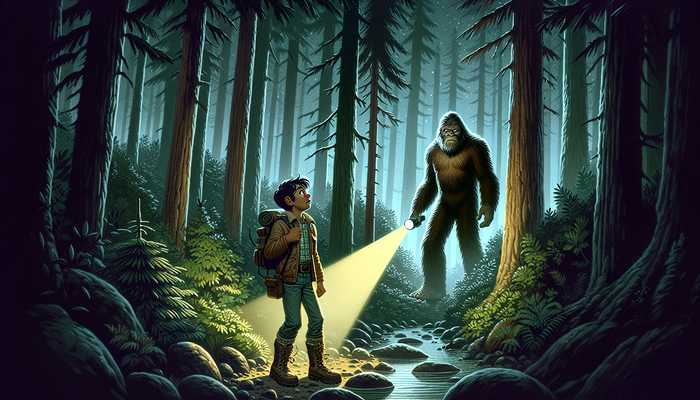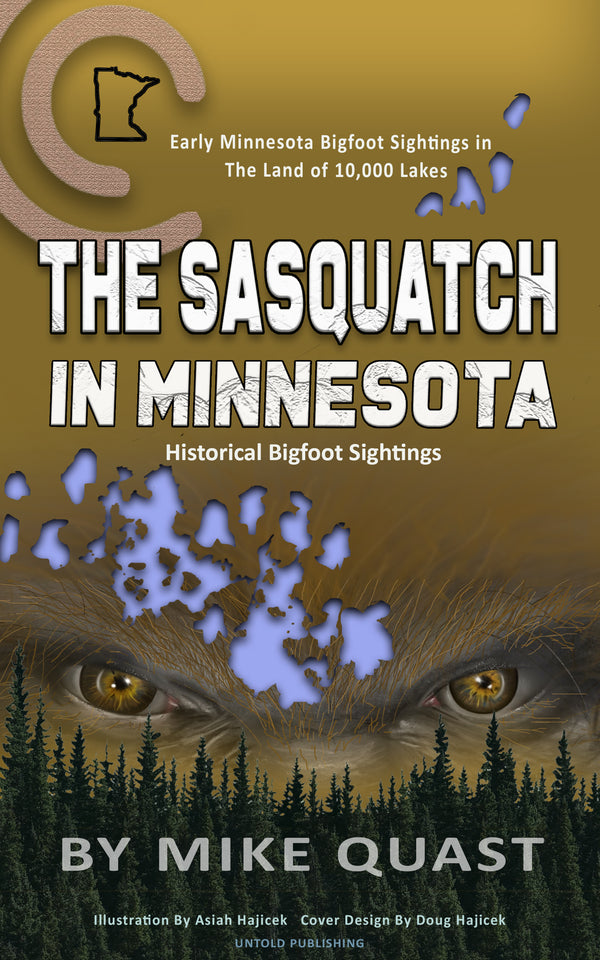Bigfoot in the Sunflower State: A Century of Kansas Sightings

By Oliver Bennett, Cryptozoologist
In the realm of cryptozoology, few creatures have captured the imagination and sparked debate quite like Bigfoot. This elusive, humanoid being, also known as Sasquatch, has been the subject of countless sightings, investigations, and legends across North America. While states like Washington, California, and Oregon have long been considered hotspots for Bigfoot activity, an unexpected contender has emerged in the heart of the Great Plains: Kansas.
As a researcher and historian with a deep fascination for the unexplained, I have long been intrigued by the persistent reports of Bigfoot sightings in the Sunflower State. Despite its relatively flat terrain and sparse population compared to other Bigfoot hotspots, Kansas boasts a rich history of encounters with these enigmatic creatures, spanning over a century.
In this article, I aim to delve into the compelling evidence and unique characteristics of the Kansas Bigfoot phenomenon, exploring the theories, investigations, and cultural significance surrounding these elusive beings. By examining the historical accounts, contemporary sightings, and ongoing research efforts, I hope to shed light on the enduring mystery of Bigfoot's presence in Kansas and its place in the larger context of cryptozoology.
The History of Bigfoot Sightings in Kansas
The history of Bigfoot sightings in Kansas is a tapestry woven with threads of mystery, intrigue, and the occasional dash of skepticism. The earliest known reports date back over a century, hinting at a long-standing presence of these enigmatic creatures in the state.
One of the most notable early sightings occurred in 1869 in Crawford County, where residents reported encountering a strange, hairy, ape-like creature they nicknamed "Old Sheff." Witnesses described the beast as having a stooping gait, long arms with large hands or claws, and the ability to walk on two legs or all fours. The creature's appearance was so unnerving that even though up to 60 citizens reportedly chased it through the fields, they were hesitant to shoot it because it looked too much like a man.
Another intriguing report from the late 1800s comes from Washington County, where locals spoke of a "wild man" or "gorilla" lurking in the woods. This creature was said to be incredibly shaggy and would alternate between walking on all fours and standing upright like a human. Once again, the witnesses' reluctance to shoot the beast due to its human-like appearance adds an extra layer of intrigue to the account.
As the 20th century unfolded, the stream of Bigfoot sightings in Kansas continued unabated. In 1978, the chief of police in Chetopa, Labette County, reported finding 2.5 miles of animal-like tracks with footprints measuring an astonishing 17 inches long and 5.625 inches wide. This discovery, made by a law enforcement official, lends an air of credibility to the ongoing mystery.
Just a few years later, in 1984, a woman and her daughter in Sedgwick County had a frightening encounter with a large, unidentified animal that seemed to follow them as they walked along a dark country lane. The persistence of such sightings, often by multiple witnesses, suggests that there may be more to the Kansas Bigfoot phenomenon than mere misidentification or hoaxes.
In recent decades, the Bigfoot Field Researchers Organization (BFRO) has played a crucial role in documenting and investigating Bigfoot sightings across the United States, including Kansas. To date, the BFRO has recorded an impressive 49 sightings in the state, spanning multiple counties and decades.
Some of the most notable recent sightings include:
- The 1999 encounter near the Marais Des Cygnes River in Linn County, where a bowhunter and his uncle spotted an 8-foot-tall, mud-covered creature wading in the swampy waters. The detailed description of the creature's appearance and behavior, as well as the witnesses' proximity to the beast, make this a particularly compelling case.
- A 2018 incident, also in Linn County, where witnesses reported seeing a large, white Bigfoot-like creature that let out a chilling, high-pitched "oooo-yaaaa" scream. The consistency of such reports, often by credible witnesses with no apparent motive for fabrication, adds weight to the possibility that there may indeed be an undiscovered species of primate lurking in the forests and grasslands of Kansas.
As we explore the rich history of Bigfoot sightings in the Sunflower State, it becomes clear that these accounts are not merely the product of overactive imaginations or misidentifications. The sheer volume and consistency of the reports, spanning over a century and involving a diverse array of witnesses, suggest that there is a genuine mystery waiting to be unraveled in the heart of America.
Unique Characteristics of Kansas Bigfoot
As I delve deeper into the Kansas Bigfoot phenomenon, I am struck by the unique characteristics that set these creatures apart from their counterparts in other regions. While Bigfoot sightings across North America share many commonalities, the reports from the Sunflower State paint a picture of a distinct and intriguing population of these elusive beings.
Size and Stature
One of the most striking features of the Kansas Bigfoot is their exceptional size and stature. Witnesses consistently describe encountering creatures that tower over humans, often reaching heights of 8 to 10 feet. This is notably taller than the average Bigfoot sightings reported in other parts of the country, where the creatures are typically said to be between 6 and 8 feet tall.
In addition to their impressive height, Kansas Bigfoot are often described as having a muscular, broad-shouldered build. Witnesses speak of creatures with barrel chests and powerful, heavily muscled arms that give them an imposing presence. This physical description suggests that the Kansas Bigfoot may be particularly well-adapted to traversing the state's varied terrain, from the dense forests along rivers and streams to the open grasslands of the prairies.
Coloration and Fur Texture
Another intriguing aspect of the Kansas Bigfoot is the diversity of their coloration and fur texture. While many sightings across North America describe the creatures as having dark brown or black fur, reports from Kansas paint a more varied picture. Witnesses have described encountering Bigfoot with fur ranging from dark brown to reddish-brown, and even mud-matted or white coats.
This variation in coloration raises fascinating questions about the potential for regional adaptations or even the existence of multiple subspecies of Bigfoot within the state. Could the lighter-colored individuals be better suited to the open, sun-drenched grasslands, while their darker counterparts inhabit the shadier forests? Or might the mud-matted appearance be a result of the creatures' affinity for the numerous rivers and streams that crisscross the Kansas landscape?
Proximity to Water Sources
Indeed, the proximity of many Kansas Bigfoot sightings to water sources is another notable characteristic. From the Marais Des Cygnes River to Chase County Lake and the South Fork Ninnescah River, these creatures seem to have a strong connection to the state's waterways. This association with water could be related to their dietary needs, as the rivers and lakes provide a rich source of fish, mussels, and other aquatic prey.
Furthermore, the presence of water may play a role in the creatures' ability to remain hidden from human eyes. The dense vegetation along riverbanks and the muddy, swampy areas surrounding lakes and streams could provide excellent cover for a creature as large as Bigfoot, allowing them to move through the landscape undetected.
Vocalizations and Communication
In addition to their physical characteristics and habitat preferences, Kansas Bigfoot are also known for their distinctive vocalizations and potential communication abilities. Witnesses have reported hearing loud, guttural screams, roars, and even what some describe as a language or form of communication between the creatures.
The 2018 Linn County sighting, where witnesses described hearing a high-pitched "oooo-yaaaa" scream, is just one example of the unique vocalizations attributed to these creatures. Such reports suggest that Kansas Bigfoot may possess a complex system of communication, perhaps even a rudimentary language, which they use to interact with one another and navigate their environment.
As a researcher, I find myself captivated by the unique characteristics of the Kansas Bigfoot population. These creatures, with their towering stature, varied coloration, and affinity for water, paint a picture of a distinct and well-adapted species that has managed to thrive in the heart of America while remaining largely hidden from human eyes.
The more I explore the Kansas Bigfoot phenomenon, the more I am convinced that there is a genuine biological and ecological mystery waiting to be unraveled. By studying the unique characteristics of these creatures and the environments they inhabit, we may gain valuable insights into the larger question of Bigfoot's existence and their place in the natural world.
Theories and Explanations for Kansas Bigfoot
As the evidence for Bigfoot's presence in Kansas continues to mount, researchers and enthusiasts have put forth various theories and explanations to account for these enigmatic creatures. From the plausible to the fantastical, these hypotheses attempt to shed light on the origins, nature, and persistence of the Kansas Bigfoot phenomenon.
Gigantopithecus Theory
One of the most intriguing theories suggests that the Kansas Bigfoot may be descendants of the extinct giant ape known as Gigantopithecus. This massive primate, which lived in Asia during the Pleistocene era, is thought by some researchers to have migrated across the Bering Strait land bridge and established populations in North America, including the central plains region that encompasses Kansas.
The Gigantopithecus theory is particularly compelling when considering the exceptional size and stature of the Kansas Bigfoot. With witnesses consistently describing creatures in the 8 to 10-foot range, these dimensions align with what is known about the extinct giant ape. Could it be that a relict population of Gigantopithecus, or a closely related species, has managed to survive and adapt to the Kansas landscape, hidden from the eyes of modern science?
Undiscovered Primate Species
Another theory that has gained traction among Bigfoot researchers is the possibility that these creatures represent an undiscovered species of primate native to North America. Proponents of this idea argue that the vast, sparsely populated regions of Kansas, with their dense forests, winding rivers, and expansive grasslands, could provide an ideal habitat for a large, undocumented hominid.
The notion of an undiscovered primate species in North America may seem far-fetched to some, but it is worth noting that new species are still being discovered in remote corners of the world. The dense forests and rugged terrain of Kansas, while not as vast or inaccessible as the jungles of South America or the mountains of Asia, could still harbor a creature that has managed to evade scientific classification.
Interdimensional or Supernatural Explanations
Of course, not all theories about the Kansas Bigfoot are rooted in conventional biology. Some researchers and enthusiasts have proposed more esoteric explanations, suggesting that these creatures may be interdimensional or supernatural in nature. This idea is often based on reports of Bigfoot sightings being accompanied by other paranormal phenomena, such as strange lights in the sky, unexplained disappearances, and even alleged encounters with extraterrestrial beings.
While the interdimensional or supernatural hypothesis may stretch the bounds of scientific credibility, it is important to approach all theories with an open mind. After all, the very existence of Bigfoot challenges our understanding of the natural world, and it would be premature to dismiss any explanation outright without thorough investigation and evidence.
Skepticism and Misidentification
On the other end of the spectrum, skeptics and detractors of the Kansas Bigfoot phenomenon often attribute sightings to misidentification of known animals, such as bears, large dogs, or even humans. They argue that the lack of definitive physical evidence, such as clear photographs or DNA samples, casts doubt on the existence of these creatures.
However, it is worth noting that the absence of evidence is not necessarily evidence of absence. The very nature of Bigfoot, as an elusive and potentially intelligent creature, makes it inherently difficult to study and document. The challenges of proving Bigfoot's existence in Kansas, with its relatively sparse population and lack of dense wilderness compared to other hotspots, are even more pronounced.
As a researcher, I believe that the truth about the Kansas Bigfoot likely lies somewhere between the extremes of skepticism and fantastical speculation. By carefully examining the available evidence, considering the unique characteristics of the creatures and their habitat, and keeping an open mind to new discoveries and explanations, we may gradually unravel the mystery of these enigmatic beings.
Ultimately, the theories and explanations surrounding the Kansas Bigfoot serve as a testament to the enduring fascination and mystery that these creatures inspire. Whether they are the descendants of an extinct giant ape, an undiscovered primate species, or something altogether more extraordinary, the quest to understand and document their existence continues to captivate researchers and enthusiasts alike.
As we explore the various hypotheses and ideas put forth to explain the Kansas Bigfoot phenomenon, it becomes clear that there is still much to be learned and discovered. By approaching this mystery with a combination of scientific rigor, open-mindedness, and a healthy dose of curiosity, we may one day unlock the secrets of these elusive creatures and their place in the natural world.
The Search for Kansas Bigfoot
The search for Bigfoot in Kansas is a multi-faceted endeavor, involving dedicated researchers, amateur enthusiasts, and even popular media. As the evidence for these creatures' presence in the state continues to mount, so too does the determination of those seeking to uncover the truth behind the mystery.
Bigfoot Field Researchers Organization (BFRO)
At the forefront of this search is the Bigfoot Field Researchers Organization (BFRO), a group that has been instrumental in documenting and investigating Bigfoot sightings across the United States, including Kansas. The BFRO maintains a comprehensive database of sightings, which currently includes an impressive 49 reports from the Sunflower State.
But the BFRO's work goes beyond merely cataloging sightings. The organization also conducts field investigations and expeditions in Kansas, with the goal of gathering physical evidence and better understanding the creatures' behavior and habitat preferences. These dedicated researchers spend countless hours in the forests, along rivers, and in the grasslands of Kansas, employing a variety of techniques to document Bigfoot's presence.
From setting up trail cameras and audio recording devices to conducting nighttime stakeouts and follow-up interviews with witnesses, the BFRO's investigators leave no stone unturned in their quest for evidence. Their meticulous approach to documentation and analysis has helped to lend credibility to the Kansas Bigfoot phenomenon, even in the face of skepticism from the scientific community.
From Bigfoot to UFOs: Hangar 1 Publishing Has You Covered!
Explore Untold Stories: Venture into the world of UFOs, cryptids, Bigfoot, and beyond. Every story is a journey into the extraordinary.
Immersive Book Technology: Experience real videos, sights, and sounds within our books. Its not just reading; its an adventure.



























